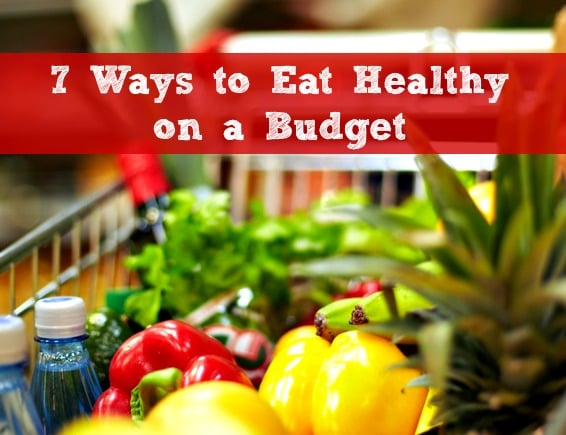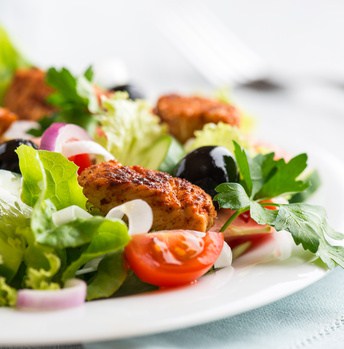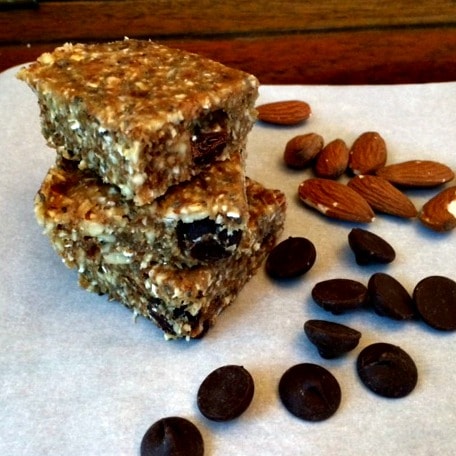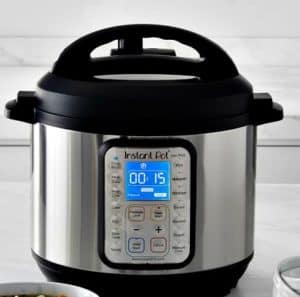 Have you ever worried that you should be buying more food that’s super healthy – maybe even some that’s organic – but thought you couldn’t afford it. If so, you’re not alone.
Have you ever worried that you should be buying more food that’s super healthy – maybe even some that’s organic – but thought you couldn’t afford it. If so, you’re not alone.
Many women want to eat healthier and feed their families a healthier diet, but don’t think it’s possible to eat healthy on a budget. They know that real, whole and organic food costs more than regular old grocery store food, so they assume that a really healthy diet is out of their price range.
That’s what I used to think, until I tried an experiment and figured out some tips for saving money on real and even organic food. Once I implemented these tips, I realized that you really can eat healthy food without breaking your budget.
You may even be able to eat healthier food while spending less money, even though healthy food often costs more. That seems kind of crazy, I know.
Here’s what happened. Recently, my family ate a real food, primarily organic, diet for a month. Although our normal diet is fairly healthy, we had read about the anti-inflammatory benefits of a “clean” diet and wanted to see if it would reduce the arthritis pain in my husband’s hands. (It did.)
So for the entire month we ate as well as we possibly could – organic dairy, organic fruits and vegetables, high-quality meat and chicken (about half organic), organic grains, free-range eggs (we have chickens!), nuts, coconut oil and olive oil. We eliminated white sugar and white flour and almost all wheat products (we ate a small amount of bread and pasta made from organic Einkorn wheat). We ate no processed food, and we rarely ate out.
And we waited for our food budget to collapse under the weight of trips to Earthfare.
But it didn’t happen. Our average monthly food bill (groceries + eating out) compared to the previous two months actually decreased slightly. So we ate better, but spent a little bit less.
If you want to eat healthier without breaking the band, here are 7 things we did that you can do too, in order to eat healthy on a budget: (includes affiliate links)
7 Ways to Eat Healthy on a Budget
• Get organized. Unless you have money to burn, you can’t wing it on a healthy food diet – you need a plan. The first step is to make a menu and grocery list every week. Although I normally plan dinners, I found that I needed to plan breakfasts and lunches too, because we couldn’t fall back on a bagel or frozen meal in a pinch.
Next, organize your refrigerator, freezer and pantry. Get rid of foods you don’t want to eat. Take stock of the healthy foods you already have on hand and put them where you can find them quickly and easily. Then, keep those areas organized; take 10 minutes every weekend to keep your refrigerator, freezer and pantry under control.
• Use everything and don’t waste anything. I hate to waste food, but I sometimes lose track of what’s in the refrigerator and end up throwing things away. But I can’t afford to throw away organic food, and you probably can’t either. So keep track of what you have and don’t let anything go to waste.
Put the date on leftovers so they don’t get too old to eat. If something needs to be eaten, incorporate it into your meal plan. If you can’t, freeze it. I could have kicked myself when I had to throw away delicious soup made from an organic chicken, simply because I didn’t use it or freeze it in time!
• Keep things simple. Don’t complicate your life with elaborate meals or stress your budget with prepared organic foods. Instead, stick with simple meals prepared well.
For example, grilled chicken breasts, baked sweet potatoes and a tossed salad; London broil with new potatoes and roasted vegetables, or a veggie-filled salad with grilled chicken all make a simple, delicious meal that saves money, time and stress. Also, go meatless occasionally and eat inexpensive foods like rice and beans or a vegetable frittata.

• Take advantage of low prices, sales and discounts. Grocery stores and discount stores carry many organic items. I bought organic staples, like chicken broth, brown rice, butter, milk and yogurt at my regular grocery store or Wal-Mart. Many of those stores also carry chicken raised without antibiotics, and Wal-Mart sometimes carries grass-fed beef.
The best selection of organic produce, however, (at least where I live) is generally found at high-end grocery stores (and at farmers’ markets or your own garden in season). But even high-end stores run sales and offer discounts. So sign up for their text or email deals and install their apps on your phone. I rarely went to Earthfare without one of their discounts, and I stocked up on items there as they went on sale.
• Make some foods you would normally buy. We figured out early in this experiment that we needed to have more healthy snacks on hand. But most snack foods are pricey and contain ingredients we were trying to avoid.
So we started making toasted walnuts, energy bars and granola every weekend. They satisfied our snack cravings and could fill in as an emergency breakfast if needed. I also made homemade salad dressings every week, and we started experimenting with making yogurt (because organic Greek yogurt is really expensive!).

• Cook extra whenever possible. Many meals can be doubled easily, with almost no extra work or mess. Put your InstantPot and slow cooker to work for you. Cooking extra food saves time, but it also saves money. When you can turn leftover dinner into lunches to take to work, it reduces the likelihood that you’ll have to run out and grab something from a restaurant.
And when you make a double batch of dinner and freeze half, you have a healthy and inexpensive “fast food” dinner on hand for a particularly hectic night, when you might otherwise pick up a fast food meal or go out to dinner.
You can find more food prep tips here that will also help you eat healthy on a budget. And if you want to learn another great way to save time and money on healthy eating, Lisa at BirthEatLove has written a great article on batch cooking, which is especially geared toward moms with kids at home. (She has 4!)
• Cut way back on eating out. Making this change does two things. First, it helps you stick to your real food eating plan, because it’s difficult to eat clean in a restaurant. Second, it keeps your food costs down because, let’s face it, eating out gets expensive.
A healthy food diet isn’t cheap, but it doesn’t have to break the bank either. With a bit of planning, organization and effort, you can feed your family well and eat healthy on a budget. Have you tried it? I’d love to hear about your experience and your best tips.
(Also published at The Huffington Post.)

Sharing with Family Fun Friday.

Cassie from True Agape says
Planning our meals ahead actually helps us save and be organize. It might cost us more time in planning at the beginning but generally you have saved a lot of time and money in doing so.
GC says
Hi Cassie – I agree. When I force myself to take the time to plan and prep, it always saves me time and money in the long run.
Gaye